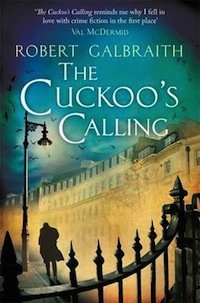
After a slightly ponderous start, the answer has to be an emphatic yes. Rowling has written an ingenious, unashamedly traditional crime novel with an antagonistic, damaged private detective bearing the unlikely name of Cormoran Strike. The Cuckoo’s Calling is not a violent novel; bodies don’t pile up over the course of its 450 pages. It is more concerned with superior storytelling, evocative description of modern London and an intricate approach to detection that feels as familiar and precise as a crossword puzzle.
Rowling’s story begins in the aftermath of the death of a wayward supermodel who fell – was she pushed? – from the balcony of her Mayfair apartment. It’s a powerful preamble from Rowling who describes the broken body of Lula Landry in the snow-clad streets, the nervy police, media scrum and hysterical headlines with prose that’s surely informed by her personal experience of press coverage and intrusion.
Several weeks after the apparent suicide of the troubled model, Cormoran Strike enters the fray along with his secretary Robin Ellacott, a wide-eyed 25-year-old temp who’s new in town. Robin’s a well-drawn foil to Strike and allows us to see his detective work and the city streets through an innocent’s eyes, though she soon reveals a talent of her own for teasing out information.
Asked to investigate the death of Landry by her brother, an initially reluctant Strike pounds the streets and bumps up against truculent cops, snooty lawyers and a monstrous movie producer. The supposed suicide soon throws up plenty of questions. Why is rapper Deeby Macc so touchy about his whereabouts that night? What did the supermodel’s attention-seeking neighbour really hear before Landry fell? And is the louche boyfriend’s alibi solid? It’s an intricate case, bursting with potential suspects and competing accounts, but Rowling’s control of her narrative is masterful. Her description of London – from joyless fine dining in Mayfair to a profanity-strewn encounter in a grotty East End boozer – is clear-sighted and witty and her knowledge of women’s fashion should have been a clue to Robert Galbraith’s real gender.
Strike is headstrong, bull-like, ex-army – his appearance is described as “a young Beethoven who had taken to boxing” – but with an unconventional family background; his office is based in the rock ‘n’ roll district of Denmark Street, a clue to his chaotic upbringing. He’s also falling apart in every sense: his business is failing, he’s walked out on his glamorous girlfriend and he’s struggling with a prosthetic leg, the result of an horrific injury in Afghanistan. He’s also drinking and his thirst for pints of Doom Bar might well boost sales of that Cornish ale. Only Strike’s taste for Tom Waits hits a false note, as if Rowling has been reading about DIs Thorne and Rebus and alighted on a moody music influence for her own investigator.
There are some passages of over-description and it can be jarring when the point of view shifts from Strike to Robin on the same page. However, I can overlook these teething troubles because Rowling’s novel soon settles into such a pleasurable, perfectly plotted read. It also demonstrates the power of crime fiction to portray the cracks and corruption in society through the eyes of an investigator – in this case a taciturn, troubled detective with a talent for piercing pomposity.
The Cuckoo’s Calling has the elegance of PD James, the sly humour of Kate Atkinson and the ingenuity of Margery Allingham. JK Rowling has reinvented the classic crime novel for a modern readership in a detective series debut that deserves its belated bestseller status.
Sphere
Print/Kindle/iBook
£7.49
CFL Rating: 5 Stars